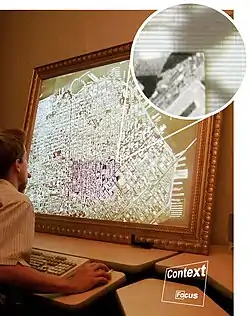Focus-plus-context screen
A focus-plus-context screen is a specialized type of display device that consists of one or more high-resolution "focus" displays embedded into a larger low-resolution "context" display. Image content is displayed across all display regions, such that the scaling of the image is preserved, while its resolution varies across the display regions.

The original focus-plus-context screen prototype consisted of an 18"/45 cm LCD screen embedded in a 5'/150 cm front-projected screen. Alternative designs have been proposed that achieve the mixed-resolution effect by combining two or more projectors with different focal lengths [1]
While the high-resolution area of the original prototype was located at a fixed location, follow-up projects have obtained a movable focus area by using a Tablet PC.
Patrick Baudisch[2] is the inventor of focus-plus-context screens (2000, while at Xerox PARC)
Advantages
- Allows users to leverage their foveal and their peripheral vision
- Cheaper to manufacture than a display that is high-resolution across the entire display surface
- Displays entirety and details of large images in a single view. Unlike approaches that combine entirety and details in software (fisheye views), focus-plus-context screens do not introduce distortion.
Disadvantages
- In existing implementations, the focus display is either fixed or moving it is physically demanding
References
- Ashdown, M.; Robinson, P. (2005). "Escritoire: A Personal Projected Display". IEEE MultiMedia. 12: 34–42. doi:10.1109/MMUL.2005.18. hdl:11025/1625.
- Patrick Baudisch
- Notes
- Patrick Baudisch; Nathan Good; Paul Stewart (2001). Focus plus context screens: combining display technology with visualization techniques. Proceedings of the 14th annual ACM Symposium on User Interface Software and Technology. pp. 31–40.
- Patrick Baudisch, Nathan Good, Victoria Bellotti, and Pamela Schraedley (2002). Keeping things in context: a comparative evaluation of focus plus context screens, overviews, and zooming. Proceedings of ACM CHI Conference on Human Factors in Computing Systems. pp. 259–266.
{{cite conference}}: CS1 maint: multiple names: authors list (link) - Yudhijit Bhattacharjee. In a Seamless Image, the Great and Small. In The New York Times, Thursday, March 14, 2002.
- Mark Ashdown; Peter Robinson (2005). Escritoire: A Personal Projected Display. IEEE Multimedia January/March 2005 (Vol. 12, No. 1). pp. 34–42. doi:10.1109/MMUL.2005.18. hdl:11025/1625.
- Johnny Lee; Scott Hudson; Jay Summet (2005). Moveable Interactive Projected Displays Using Projector Based Tracking. Proceedings of the 18th annual ACM Symposium on User Interface Software and Technology. pp. 63–72.
- Johan Sanneblad; Lars Erik Holmquist (2005). Ubiquitous Graphics. In ACM SIGGRAPH 2005 Emerging Technologies.